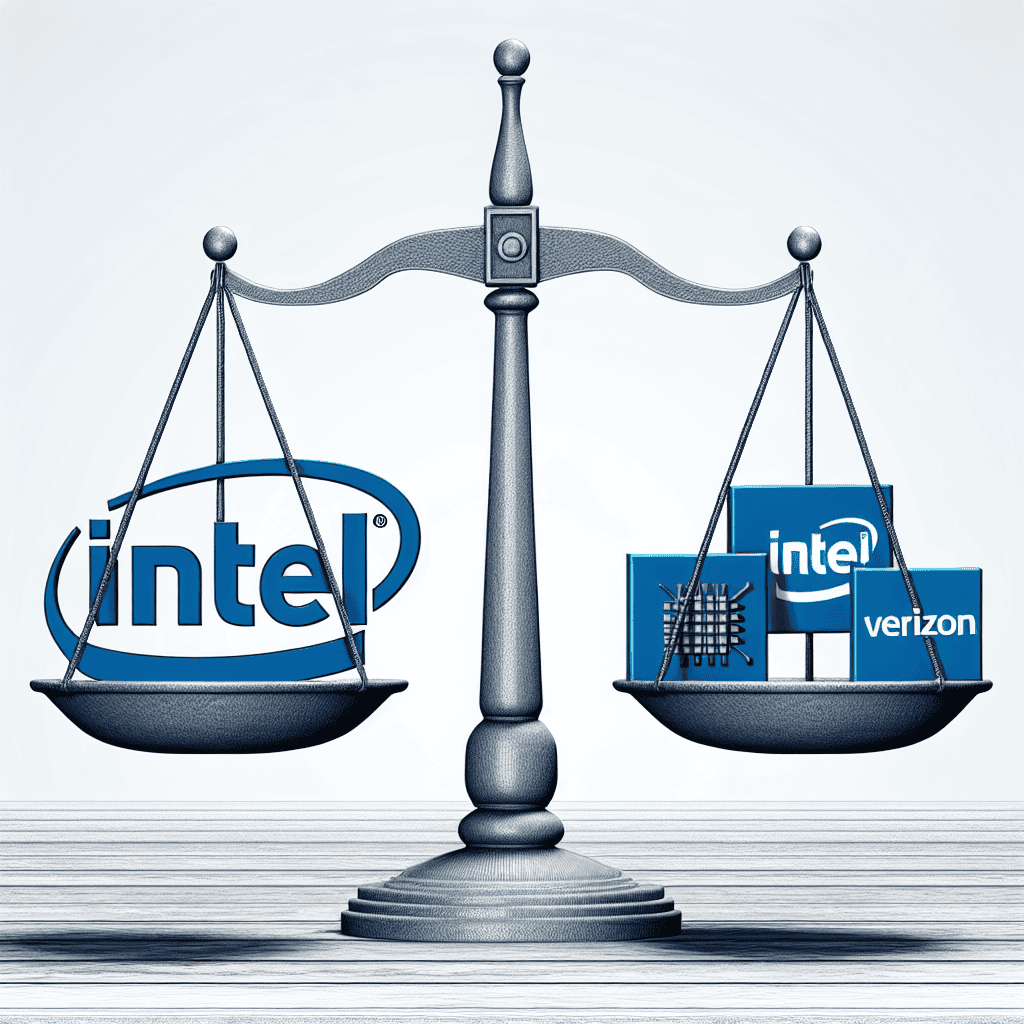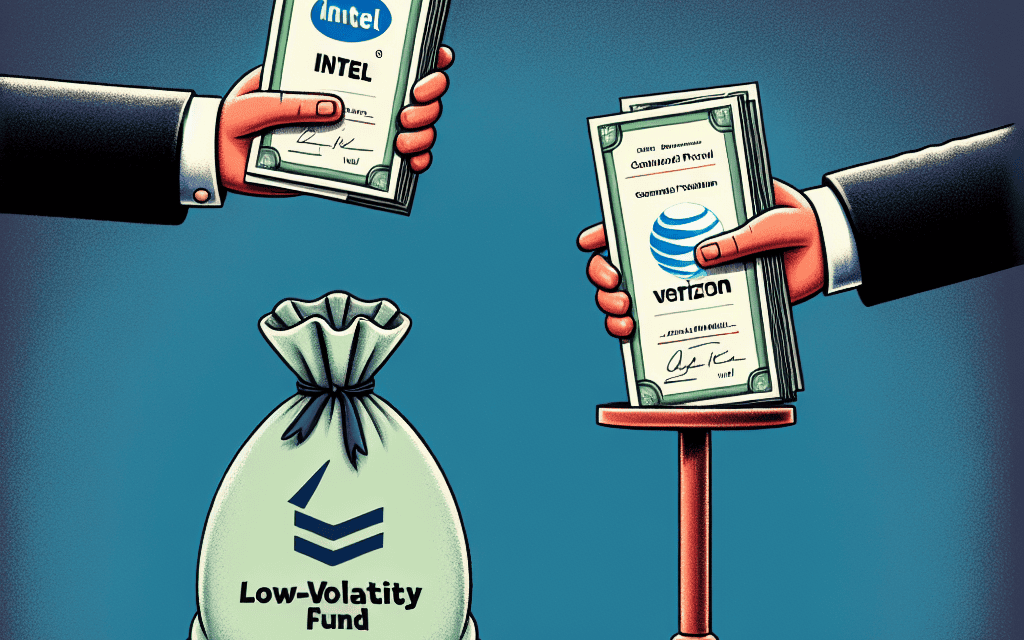“Strategic Shifts: Low-Volatility Fund Strengthens with Intel and Verizon, Streamlines by Letting Go of AT&T and Micron.”
Introduction
In a strategic move reflecting its investment philosophy, a prominent low-volatility fund has recently adjusted its portfolio by acquiring significant stakes in technology and telecommunications giants Intel and Verizon, while divesting from AT&T and Micron. This shift underscores the fund’s commitment to minimizing risk while capitalizing on stable, long-term growth opportunities. By investing in Intel, a leader in semiconductor innovation, and Verizon, a major player in the telecommunications sector, the fund aims to leverage the robust market positions and consistent performance of these companies. Conversely, the decision to divest from AT&T and Micron suggests a strategic reallocation of resources, possibly in response to market dynamics or company-specific factors that may not align with the fund’s low-volatility strategy. This rebalancing act highlights the fund’s proactive approach to managing its portfolio in a rapidly evolving economic landscape.
Impact Of Low-Volatility Funds On Tech Stocks
The recent strategic moves by a prominent low-volatility fund, which has acquired significant stakes in Intel and Verizon while divesting from AT&T and Micron, underscore the evolving dynamics within the technology and telecommunications sectors. This shift in investment strategy highlights the fund’s focus on stability and long-term growth potential, reflecting broader trends in the market where investors are increasingly seeking to balance risk and reward.
Low-volatility funds are designed to minimize risk by investing in stocks that exhibit less price fluctuation compared to the broader market. These funds are particularly appealing during periods of economic uncertainty, as they offer a more stable investment option. The decision to acquire Intel and Verizon aligns with this objective, as both companies are established leaders in their respective industries, offering a combination of steady revenue streams and potential for future growth.
Intel, a giant in the semiconductor industry, has been undergoing a transformation to regain its competitive edge. With a renewed focus on innovation and expansion into new markets such as artificial intelligence and autonomous vehicles, Intel presents a compelling case for investors seeking stability with growth potential. The company’s robust financial health and strategic initiatives aimed at addressing past challenges make it an attractive option for low-volatility funds. By investing in Intel, the fund is betting on the company’s ability to navigate industry shifts and capitalize on emerging opportunities.
Similarly, Verizon, a leader in telecommunications, offers a stable investment with its strong market position and consistent revenue generation. The company’s focus on expanding its 5G network and enhancing its digital services portfolio positions it well for future growth. Verizon’s reliable dividend payouts and solid financial performance make it a suitable choice for low-volatility funds aiming to provide investors with steady returns. The acquisition of Verizon shares reflects confidence in the company’s capacity to maintain its leadership in a rapidly evolving industry.
Conversely, the divestment from AT&T and Micron indicates a strategic reallocation of resources. AT&T, despite its significant presence in the telecommunications sector, has faced challenges related to its debt levels and strategic direction. The decision to divest from AT&T may be driven by concerns over the company’s ability to deliver consistent returns amid these challenges. By reallocating resources to more stable investments like Verizon, the fund aims to enhance its risk-adjusted returns.
Micron, a key player in the memory and storage solutions market, has experienced volatility due to fluctuations in demand and pricing pressures. While the company has strong growth prospects, particularly with the increasing demand for memory in data centers and consumer electronics, the inherent volatility in its business may not align with the fund’s low-risk investment strategy. The divestment from Micron suggests a preference for companies with more predictable performance and less exposure to cyclical downturns.
In conclusion, the strategic decisions made by the low-volatility fund to acquire Intel and Verizon while divesting from AT&T and Micron reflect a calculated approach to managing risk and optimizing returns. By focusing on companies with stable revenue streams and growth potential, the fund aims to provide investors with a balanced portfolio that can withstand market fluctuations. This shift not only highlights the fund’s commitment to minimizing volatility but also underscores the broader trend of investors seeking stability in an uncertain economic environment. As the technology and telecommunications sectors continue to evolve, such strategic reallocations will likely play a crucial role in shaping investment landscapes.
Strategic Moves In The Telecom Sector
In a strategic maneuver within the telecom sector, a prominent low-volatility fund has recently adjusted its portfolio by acquiring significant stakes in Intel and Verizon, while divesting from AT&T and Micron. This decision reflects a calculated response to the evolving dynamics of the telecommunications and technology industries, aiming to optimize returns while minimizing risk. The acquisition of Intel and Verizon shares underscores the fund’s confidence in these companies’ potential for stable growth and resilience in a rapidly changing market. Intel, a leader in semiconductor manufacturing, has been at the forefront of technological innovation, particularly in the areas of artificial intelligence and data centers. As the demand for advanced computing solutions continues to rise, Intel’s strategic investments in next-generation technologies position it as a key player poised for sustained growth. By adding Intel to its portfolio, the fund is aligning itself with a company that not only has a strong market presence but also a robust pipeline of future innovations.
Similarly, Verizon’s inclusion in the fund’s portfolio highlights the company’s strong position in the telecommunications sector. As one of the largest wireless carriers in the United States, Verizon has consistently demonstrated its ability to adapt to changing consumer needs and technological advancements. The rollout of 5G technology has been a significant focus for Verizon, promising faster speeds and enhanced connectivity. This strategic emphasis on 5G aligns with the fund’s objective of investing in companies that are well-positioned to capitalize on emerging trends. Moreover, Verizon’s commitment to expanding its network infrastructure and enhancing customer experience further solidifies its reputation as a reliable and forward-thinking telecommunications provider.
Conversely, the decision to divest from AT&T and Micron reflects a strategic realignment of the fund’s investment priorities. AT&T, despite its extensive telecommunications network and media assets, has faced challenges in recent years, including high levels of debt and competitive pressures. The fund’s decision to reduce its exposure to AT&T may be driven by a desire to mitigate potential risks associated with these challenges. By reallocating resources to companies with more promising growth trajectories, the fund aims to enhance its overall portfolio performance.
Micron, a major player in the memory and storage solutions market, has also been removed from the fund’s holdings. While Micron has benefited from the increasing demand for memory products, the cyclical nature of the semiconductor industry can introduce volatility. The fund’s divestment from Micron may be a strategic move to reduce exposure to market fluctuations and focus on more stable investment opportunities. This decision aligns with the fund’s overarching goal of maintaining a low-volatility portfolio that can weather market uncertainties.
In conclusion, the low-volatility fund’s recent acquisitions and divestments within the telecom sector reflect a strategic approach to navigating the complexities of the industry. By investing in Intel and Verizon, the fund is positioning itself to benefit from technological advancements and the growing demand for connectivity solutions. Simultaneously, the divestment from AT&T and Micron indicates a shift towards minimizing risk and optimizing returns. As the telecommunications landscape continues to evolve, the fund’s strategic moves underscore its commitment to maintaining a balanced and resilient portfolio, capable of delivering consistent performance in an ever-changing market environment.
Analyzing The Shift From AT&T To Verizon
In a strategic move that has caught the attention of investors and analysts alike, a prominent low-volatility fund has recently adjusted its portfolio by acquiring significant stakes in Intel and Verizon, while divesting from AT&T and Micron. This shift in investment strategy reflects a nuanced approach to balancing risk and reward in an ever-evolving market landscape. By examining the rationale behind these decisions, we can gain insights into the fund’s broader investment philosophy and the factors influencing its choices.
The decision to divest from AT&T and invest in Verizon is particularly noteworthy, as it underscores a shift in confidence from one telecommunications giant to another. AT&T, long considered a staple in the telecommunications sector, has faced challenges in recent years, including a heavy debt load and strategic missteps in its media ventures. These issues have raised concerns about the company’s ability to maintain its dividend and sustain long-term growth. In contrast, Verizon has demonstrated a more focused approach, concentrating on its core wireless business and making strategic investments in 5G technology. This focus on innovation and infrastructure has positioned Verizon as a more attractive option for investors seeking stability and growth potential.
Moreover, the acquisition of Intel shares aligns with the fund’s low-volatility strategy, as Intel is a well-established player in the semiconductor industry. Despite facing increased competition from companies like AMD and Nvidia, Intel remains a dominant force, particularly in the data center and personal computing markets. The company’s ongoing efforts to revitalize its product lineup and expand its manufacturing capabilities have instilled confidence in its ability to navigate industry challenges. By investing in Intel, the fund is betting on the company’s capacity to leverage its technological expertise and market position to deliver consistent returns.
Conversely, the decision to divest from Micron reflects a cautious approach to the volatile memory chip market. While Micron has shown impressive growth and innovation, the cyclical nature of the memory industry poses inherent risks. Fluctuations in supply and demand, coupled with price volatility, can significantly impact profitability. By reducing exposure to Micron, the fund is mitigating potential risks associated with market unpredictability, thereby aligning with its low-volatility mandate.
This strategic reallocation of assets highlights the fund’s commitment to maintaining a balanced portfolio that prioritizes stability while capitalizing on growth opportunities. The shift from AT&T to Verizon, in particular, illustrates a preference for companies with clear strategic direction and robust infrastructure investments. Furthermore, the inclusion of Intel underscores the importance of investing in established industry leaders with a track record of innovation and resilience.
In conclusion, the recent portfolio adjustments made by this low-volatility fund reflect a deliberate and calculated approach to navigating the complexities of the current market environment. By divesting from AT&T and Micron and acquiring stakes in Verizon and Intel, the fund is positioning itself to capitalize on emerging trends while minimizing exposure to potential risks. This strategic shift not only aligns with the fund’s overarching investment philosophy but also serves as a testament to the dynamic nature of portfolio management in response to evolving market conditions. As investors continue to seek stability and growth, such strategic decisions will undoubtedly play a crucial role in shaping the future of investment strategies.
The Role Of Intel In Low-Volatility Portfolios

In the ever-evolving landscape of investment strategies, low-volatility funds have emerged as a popular choice for investors seeking stability and consistent returns. These funds aim to minimize risk by investing in stocks that exhibit lower price fluctuations compared to the broader market. Recently, a notable low-volatility fund made strategic adjustments to its portfolio by acquiring shares in Intel and Verizon while divesting from AT&T and Micron. This move underscores the critical role that Intel plays in low-volatility portfolios and highlights the broader implications for investors.
Intel, a global leader in semiconductor manufacturing, has long been a staple in technology-focused investment portfolios. Its reputation for innovation and market leadership makes it an attractive option for low-volatility funds. The decision to acquire Intel shares reflects the fund’s confidence in the company’s ability to deliver steady performance amidst market uncertainties. Intel’s robust financial health, characterized by strong cash flows and a solid balance sheet, provides a cushion against market volatility. Furthermore, its strategic initiatives in expanding its product offerings and entering new markets position it well for sustained growth.
The acquisition of Intel by the low-volatility fund is not merely a reflection of the company’s past performance but also an endorsement of its future potential. Intel’s ongoing investments in research and development, particularly in areas such as artificial intelligence and autonomous driving, are expected to drive long-term growth. These initiatives align with the fund’s objective of minimizing risk while capitalizing on emerging opportunities. By including Intel in its portfolio, the fund aims to benefit from the company’s technological advancements and its ability to adapt to changing market dynamics.
In addition to Intel, the fund’s acquisition of Verizon further emphasizes its focus on stability and reliable returns. Verizon, a leading telecommunications company, is known for its strong market position and consistent dividend payouts. The inclusion of Verizon complements the fund’s strategy by providing exposure to a sector that is less susceptible to economic downturns. Telecommunications services are considered essential, and demand remains relatively stable regardless of economic conditions. This characteristic aligns with the fund’s objective of reducing volatility and ensuring a steady income stream for investors.
Conversely, the decision to divest from AT&T and Micron reflects a strategic shift in the fund’s approach. While AT&T has been a prominent player in the telecommunications industry, recent challenges, including high debt levels and competitive pressures, have raised concerns about its ability to maintain stable performance. By divesting from AT&T, the fund seeks to mitigate potential risks associated with these uncertainties. Similarly, the decision to sell Micron shares is indicative of the fund’s cautious stance towards the semiconductor industry, which is subject to cyclical fluctuations and rapid technological changes.
In conclusion, the recent portfolio adjustments by the low-volatility fund highlight the pivotal role that Intel plays in achieving the fund’s objectives. By acquiring Intel and Verizon, the fund reinforces its commitment to stability and long-term growth. These strategic moves reflect a broader trend among low-volatility funds to prioritize companies with strong fundamentals and growth potential. As investors continue to navigate an unpredictable market environment, the inclusion of Intel in low-volatility portfolios serves as a testament to the company’s enduring value and its ability to weather market fluctuations.
Understanding The Divestment From Micron
In the ever-evolving landscape of investment strategies, the recent moves by a prominent low-volatility fund have captured the attention of market analysts and investors alike. The fund’s decision to acquire shares in Intel and Verizon while divesting from AT&T and Micron reflects a strategic shift that warrants closer examination. Understanding the rationale behind these decisions, particularly the divestment from Micron, provides valuable insights into the fund’s approach to managing risk and optimizing returns.
Micron Technology, a key player in the semiconductor industry, has long been regarded as a significant investment opportunity due to its role in producing memory and storage solutions. However, the decision to divest from Micron suggests a reassessment of the company’s risk profile. One possible reason for this move could be the inherent volatility associated with the semiconductor sector. The industry is characterized by rapid technological advancements and cyclical demand patterns, which can lead to unpredictable earnings and stock price fluctuations. By divesting from Micron, the fund may be seeking to reduce its exposure to these uncertainties, aligning with its low-volatility investment mandate.
Moreover, the global semiconductor market has been facing supply chain disruptions and geopolitical tensions, which have further contributed to the volatility in the sector. These challenges have the potential to impact Micron’s production capabilities and profitability, making it a less attractive option for a fund focused on stability. In contrast, the acquisition of Intel, another major player in the semiconductor industry, might be seen as a strategic move to maintain exposure to the sector while opting for a company perceived as having a more stable operational outlook. Intel’s diversified product portfolio and ongoing investments in innovation could offer a more balanced risk-reward profile, aligning with the fund’s objectives.
Transitioning to the telecommunications sector, the divestment from AT&T and the acquisition of Verizon shares also reflect a calculated shift in strategy. AT&T has been undergoing significant restructuring efforts, including divestitures and strategic realignments, which may have introduced an element of uncertainty that the fund seeks to avoid. On the other hand, Verizon’s strong market position and consistent performance in the telecommunications industry present a more appealing option for a low-volatility fund. Verizon’s focus on expanding its 5G network and its stable revenue streams from wireless services provide a foundation for steady growth, making it an attractive addition to the fund’s portfolio.
In summary, the fund’s recent acquisitions and divestments highlight a strategic realignment aimed at minimizing risk while capitalizing on opportunities for stable growth. The decision to divest from Micron underscores the fund’s cautious approach to managing volatility in the semiconductor sector, while the acquisition of Intel suggests a preference for companies with a more predictable operational trajectory. Similarly, the shift from AT&T to Verizon in the telecommunications sector reflects a desire to invest in companies with a proven track record of stability and growth potential. As the investment landscape continues to evolve, these strategic moves offer a glimpse into the fund’s priorities and its commitment to maintaining a low-volatility portfolio.
Investment Strategies In The Semiconductor Industry
In the ever-evolving landscape of the semiconductor industry, investment strategies must be carefully crafted to navigate the complexities and volatilities inherent in this sector. Recently, a prominent low-volatility fund made strategic adjustments to its portfolio, acquiring shares in Intel and Verizon while divesting from AT&T and Micron. This move reflects a calculated approach to balancing risk and opportunity within the semiconductor and telecommunications industries.
The decision to acquire Intel is particularly noteworthy, given the company’s pivotal role in the semiconductor industry. Intel, a leader in microprocessor manufacturing, has been at the forefront of technological innovation for decades. By investing in Intel, the fund is positioning itself to benefit from the company’s ongoing advancements in chip technology, which are crucial for powering a wide array of devices, from personal computers to data centers. Moreover, Intel’s recent strategic initiatives, including its focus on expanding its foundry services and enhancing its manufacturing capabilities, suggest a promising trajectory for future growth. This acquisition aligns with the fund’s low-volatility strategy, as Intel’s established market presence and robust financial health offer a degree of stability amidst the sector’s inherent fluctuations.
In tandem with the acquisition of Intel, the fund’s decision to invest in Verizon underscores a strategic pivot towards telecommunications, a sector that is increasingly intertwined with semiconductor technology. Verizon, a leading telecommunications company, is at the forefront of the 5G revolution, which is set to drive significant demand for advanced semiconductor components. By investing in Verizon, the fund is not only capitalizing on the growth potential of 5G technology but also diversifying its portfolio to include a stable, dividend-paying company. This move reflects a broader strategy to mitigate risk by investing in companies with strong cash flows and consistent performance, thereby aligning with the fund’s low-volatility mandate.
Conversely, the divestment from AT&T and Micron signals a shift in the fund’s investment strategy. AT&T, while a major player in telecommunications, has faced challenges related to its debt levels and strategic direction. By divesting from AT&T, the fund is likely seeking to reduce exposure to potential financial instability and refocus its resources on more promising opportunities. Similarly, the decision to divest from Micron, a key player in the memory chip market, may be driven by concerns over the cyclical nature of the memory industry. While Micron has demonstrated strong performance in recent years, the memory market is known for its volatility, influenced by fluctuating demand and pricing pressures. By reallocating resources away from Micron, the fund is likely aiming to minimize exposure to these cyclical risks.
In conclusion, the fund’s recent portfolio adjustments reflect a strategic approach to navigating the semiconductor industry’s complexities. By acquiring Intel and Verizon, the fund is positioning itself to capitalize on technological advancements and the growth of 5G, while maintaining a focus on stability and consistent returns. Meanwhile, the divestment from AT&T and Micron highlights a prudent effort to mitigate risk and optimize the portfolio’s performance. As the semiconductor industry continues to evolve, such strategic maneuvers will be essential for investors seeking to balance opportunity with risk in this dynamic sector.
Evaluating The Performance Of Low-Volatility Funds
In the ever-evolving landscape of investment strategies, low-volatility funds have garnered significant attention for their ability to provide stability and consistent returns, particularly during turbulent market conditions. These funds, which focus on minimizing risk while achieving moderate growth, have recently made notable adjustments to their portfolios. Specifically, a prominent low-volatility fund has acquired shares in Intel and Verizon, while divesting from AT&T and Micron. This strategic reallocation of assets prompts a closer examination of the performance and rationale behind such decisions.
To begin with, the acquisition of Intel and Verizon shares by the low-volatility fund underscores a strategic pivot towards companies with robust fundamentals and stable cash flows. Intel, a leading player in the semiconductor industry, has demonstrated resilience through its diversified product offerings and strong market position. The company’s focus on innovation and expansion into new markets, such as artificial intelligence and autonomous vehicles, presents a promising growth trajectory. Similarly, Verizon, a stalwart in the telecommunications sector, offers a reliable dividend yield and a solid balance sheet. Its ongoing investments in 5G technology and infrastructure further enhance its appeal as a stable, long-term investment.
Conversely, the decision to divest from AT&T and Micron reflects a calculated move to mitigate potential risks associated with these companies. AT&T, despite its extensive telecommunications network, has faced challenges related to its high debt levels and competitive pressures in the media landscape. The company’s recent strategic shifts, including divestitures and restructuring efforts, may introduce uncertainties that are less aligned with the low-volatility fund’s objectives. Meanwhile, Micron, a key player in the memory and storage solutions industry, is subject to the cyclical nature of the semiconductor market. Fluctuations in demand and pricing can lead to volatility, which may not align with the fund’s risk-averse strategy.
The reallocation of assets within the low-volatility fund is indicative of a broader trend among such funds to prioritize stability and risk management. By focusing on companies with strong financial health and predictable earnings, these funds aim to shield investors from the erratic swings often seen in the broader market. This approach is particularly appealing to investors seeking to preserve capital while still participating in market growth.
Moreover, the performance of low-volatility funds is often evaluated based on their ability to deliver consistent returns with reduced risk. Historical data suggests that these funds tend to outperform during market downturns, providing a buffer against losses. However, it is important to note that during bull markets, low-volatility funds may underperform compared to more aggressive investment strategies. This trade-off is a key consideration for investors who prioritize capital preservation over maximizing returns.
In conclusion, the recent portfolio adjustments by a low-volatility fund, involving the acquisition of Intel and Verizon and the divestment from AT&T and Micron, highlight the fund’s commitment to maintaining a balanced and risk-averse investment strategy. By carefully selecting companies with strong fundamentals and stable growth prospects, the fund aims to deliver consistent returns while minimizing exposure to market volatility. As investors continue to navigate uncertain economic landscapes, low-volatility funds remain a compelling option for those seeking a prudent approach to wealth management.
Q&A
1. **What is a low-volatility fund?**
A low-volatility fund is an investment fund that aims to provide returns with lower risk by investing in stocks with historically lower price volatility.
2. **Why would a low-volatility fund acquire Intel?**
A low-volatility fund might acquire Intel if the company is perceived to have stable earnings, a strong market position, and lower stock price volatility compared to other tech stocks.
3. **Why would a low-volatility fund acquire Verizon?**
Verizon may be acquired by a low-volatility fund due to its consistent revenue streams, strong dividend payouts, and relatively stable stock performance in the telecommunications sector.
4. **Why would a low-volatility fund divest AT&T?**
A low-volatility fund might divest AT&T if the company is experiencing increased volatility, financial instability, or strategic shifts that could lead to unpredictable stock performance.
5. **Why would a low-volatility fund divest Micron?**
Micron could be divested by a low-volatility fund if its stock exhibits high volatility due to factors like fluctuating memory chip prices or cyclical industry trends.
6. **What are the potential benefits of acquiring Intel and Verizon for a low-volatility fund?**
Acquiring Intel and Verizon can provide a low-volatility fund with exposure to stable, dividend-paying companies with strong market positions, potentially enhancing the fund’s risk-adjusted returns.
7. **What are the potential risks of divesting AT&T and Micron for a low-volatility fund?**
Divesting AT&T and Micron could lead to missed opportunities if these companies experience significant growth or recovery, potentially reducing the fund’s overall returns.
Conclusion
The decision by a low-volatility fund to acquire Intel and Verizon while divesting AT&T and Micron suggests a strategic shift towards companies perceived as having more stable earnings and lower risk profiles. Intel and Verizon are often seen as established players with strong market positions and consistent cash flows, aligning with the fund’s low-volatility investment strategy. Conversely, the divestment from AT&T and Micron may indicate concerns about higher volatility or less predictable performance in these companies. This reallocation reflects the fund’s focus on minimizing risk while seeking steady returns, consistent with its investment philosophy.





